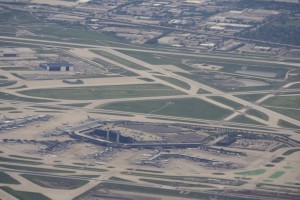CDA releases steps to address airport noise
Chronicle Media — August 2, 2015
The Chicago Department of Aviation will be making significant changes to flight departure traffic by balancing the use of O’Hare’s runways at night, prioritizing the building of additional runways to reduce noise concentrated over certain neighborhoods and explore steps necessary to provide further sound insulation to residents.
The Chicago Department of Aviation (CDA) Friday released a new plan to address airport noise while ensuring the long-term health of O’Hare International Airport and the city’s economy.
The plan addresses noise in four areas: abatement, mitigation, communication and reporting, and citizen involvement.
The CDA will be making significant changes to flight departure traffic by balancing the use of O’Hare’s runways at night, prioritizing the building of additional runways to reduce noise concentrated over certain neighborhoods and explore steps necessary to provide further sound insulation to residents.
“The solutions released today are the product of months of analysis, and collaboration with community groups and aviation experts,” Commissioner Ginger S. Evans said. “We know that airport noise is a challenge for many residents, but we are confident that we can move forward with concrete steps to ensure a higher quality of life for O’Hare’s neighbors, while maximizing the safety and efficiency of the world’s busiest airport. The city takes very seriously the impact of airport noise, but we are required to balance that with the impact on the thousands of people who rely upon O’Hare each day.”
Abatement
The overreaching goal of the CDA is to pursue noise abatement strategies — operational changes that will balance noise impact, without jeopardizing safety or reducing the efficiency of the airport.
The CDA is prioritizing changes in the Fly Quiet Program in order to address nighttime noise, a main area of concern for both the department and the surrounding communities. The CDA intends to develop a new rotation concept for the Fly Quiet Program that is intended to spread out noise impacts and relieve concentrated noise occurrences in certain communities for nighttime hours.
The CDA is preparing detailed analysis to enhance Fly Quiet preferential runways for consideration by the O’Hare Noise Compatibility Commission (ONCC).
The CDA also is stressing that it is in the community’s interest to complete the airfield so that use of the runways can be finally balanced as intended in the original design. Not only will use of the airfield be balanced between the north and south runways, the use of east flow and west flow traffic may be balanced from the current 70/30 split to closer to a 60/40 split.
All of these goals will require collaboration with the FAA, airlines, the ONCC and all community groups involved.
Mitigation
The CDA will work with the FAA to identify additional mitigation for homes and facilities impacted by noise. This additional mitigation could include previously insulated homes within the 70 DNL, and other noise-sensitive facilities. These efforts will be ongoing. To date, the FAA and CDA combined have spent more than $600 million in residential sound insulation funding and more than $351 million on school sound insulation, which includes more than 10,900 homes and 123 schools.
Communication and Reporting
In order to enhance communication with residents, the CDA plans to investigate the feasibility of an online “live chat” feature for citizen inquires relating to noise, an airport specific alternative to the City of Chicago’s 311 City Services, and a mobile application for reporting airport noise. The CDA will continue the use of WebTrak software and provide more community education on the benefits and uses of the system. Also, the CDA will upgrade the CDA web site to include expanded content on airport noise and provide practical information to residents about airfield operations.
Community Outreach Activities
The City proposes that the ONCC provide a forum for direct citizen engagement with the ONCC in order to reflect their comments or concerns regarding any recommendations presented to the CDA and the FAA.
In addition to these four key areas, the CDA will continue to analyze the potential of long-term solutions to noise, including phasing out the MD -80 aircraft fleet at O’Hare, reducing Stage 3 fleet aircraft and closely monitoring the FAA’s re-evaluation of the 65 DNL noise metric.
Intersecting Runways
The CDA proposes that Runways 14L-32R and 14R-32L must be decommissioned as planned due to significant safety issues with an antiquated, intersecting airfield configuration, a lack of operational efficiency, and increased costs associated with keeping the runways open. Additionally, the CDA opposes retaining these runways because, based on their low use by FAA Air Traffic, they can only provide negligible noise benefit to the surrounding communities — particularly 14L-32R. They also will prevent future airport development, which is needed to further support peak hour activity and traffic during inclement weather.
“We have put forward a comprehensive effort to reduce noise in our communities and ensure O’Hare remains world-class airports for decades to come,” Evan said. “I look forward to continuing this dialogue with concerned citizens and organizations who wish to have a serious discussion about the future of our city’s airports.”
The complete Chicago Department of Aviation analysis can be found at: http://goo.gl/rtwgKg
— CDA releases steps to address airport noise —







